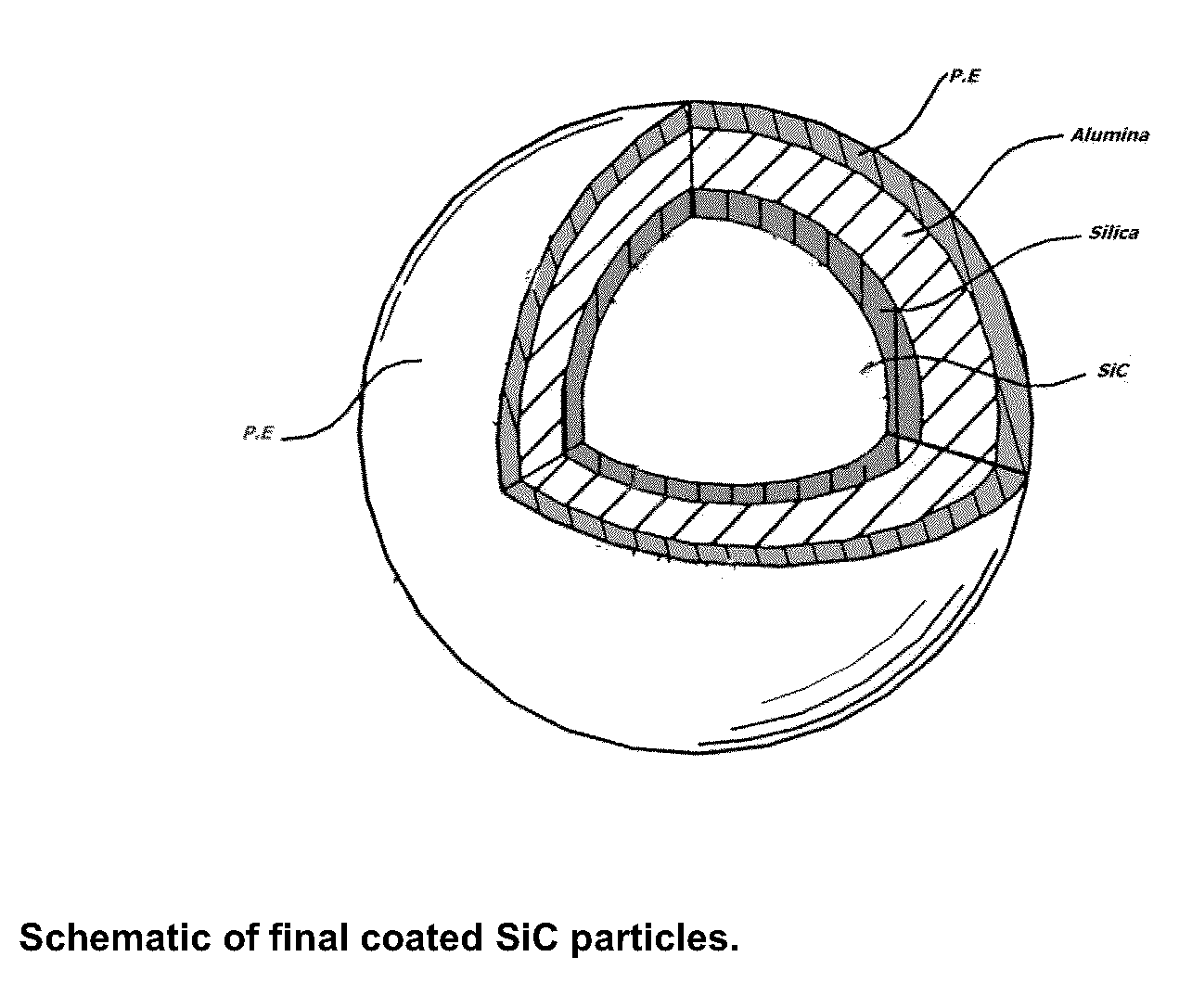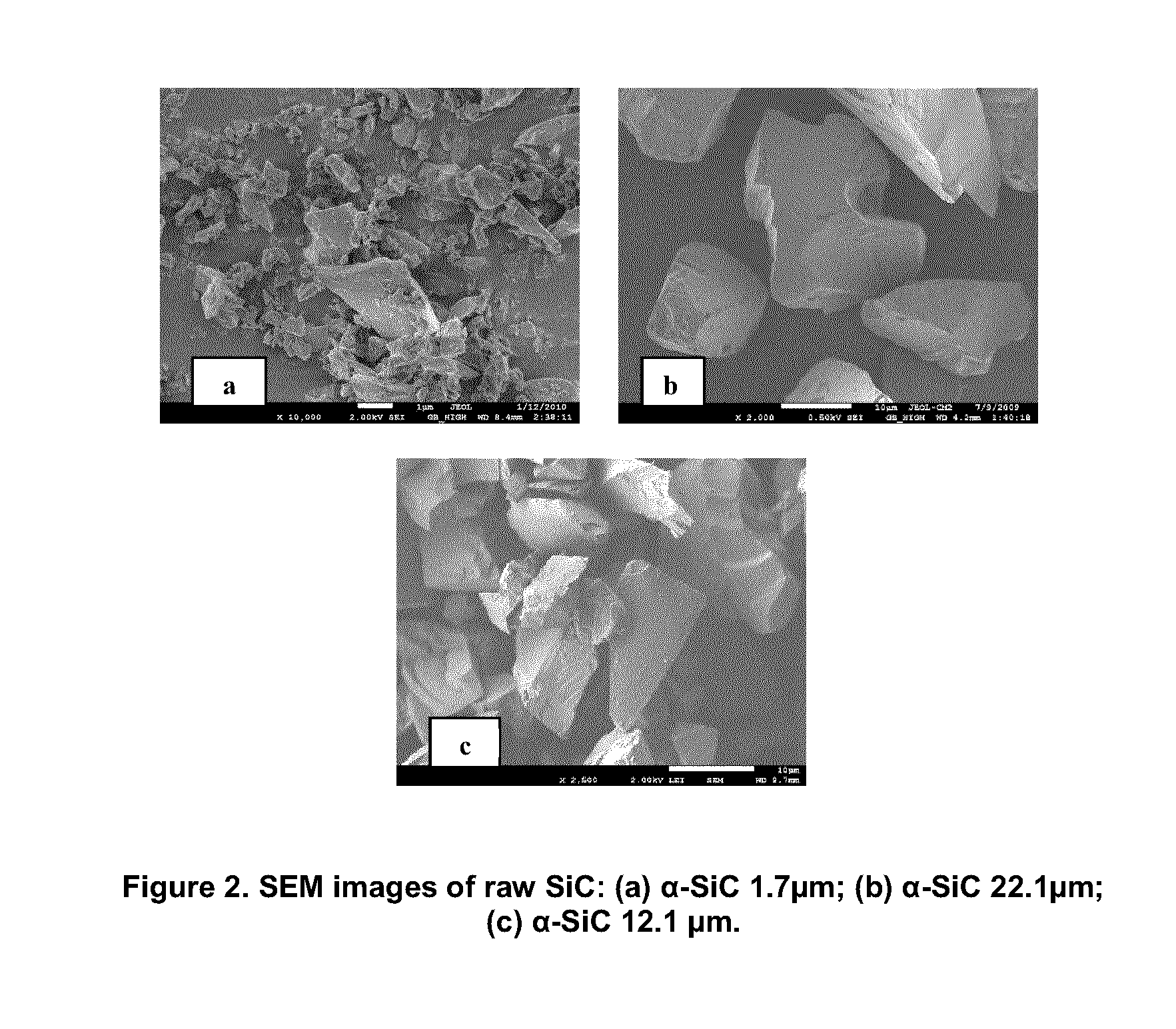POROUS SiC CERAMIC AND METHOD FOR THE FABRICATION THEREOF
a technology of porous silicon carbide and ceramics, applied in ceramics, domestic applications, other domestic objects, etc., can solve the problems of reducing bulk strength, reducing the efficiency of final products, and oxidizing to silicon dioxide relatively easily, so as to improve mechanical strength, reduce the degree of control over porosity and pore, and improve the effect of mechanical strength
- Summary
- Abstract
- Description
- Claims
- Application Information
AI Technical Summary
Benefits of technology
Problems solved by technology
Method used
Image
Examples
example 1
Oxidation Behaviour of SiC Particles
[0129]SiC particles were oxidized in air at temperatures of 900° C., 1100° C., 1200° C. and 1300° C. with a soaking time of 3 to 9 hours. During each measurement, the evaluated amount of SiC particles was heated at a rate of 10° C. / min in the furnace. After heat treatment, the weight of the sample was measured again. FIGS. 3 and 4 give the X-ray diffraction (XRD) patterns of α-SiC 1.7 μm and α-SiC 22.1 μm before and after oxidation, at different temperatures, respectively. At temperatures above 1250° C., the phase of SiO2 changes to form cristoballite. The oxidation data, plotted as relative mass changes versus time for different samples in an 8-hour oxidation is given in FIGS. 5 and 6. As can be seen on these figures, the amount of relative mass change is in direct relation to the oxidation temperature and has an inverse relation to the particle size. The morphology of the α-SiC 1.7 μm before and after oxidation is illustrated in FIG. 7. It was f...
example 2
[0132]Alumina sol was synthesized with a method developed by Yoldas [6]. Aluminum isopropoxide (AlP, Aldrich, 98%) was used as the alkoxide source of alumina. In a typical experiment, distilled water was heated up to 85° C. followed by addition of AlP in powder form. After one hour of stirring, the resulting white precipitate was peptized by adding a small amount of HCl, 10%, (Merck, 37%) in order to set the pH of the solution to 4. A transparent solution was formed after 24 hours of stirring. The resulting sol was cooled to room temperature. The reaction was performed in the four-neck reactor equipped with a heater and a magnetic stirrer under reflux. The molar ratio of water to AlP was 100:1. The sol was further heated at 45° C. in order to increase the concentration of the sol from 0.56 M to 1.5 M.
example 3
[0133]FIG. 8 shows the X-ray diffraction patterns for dried alumina sol after heat treatment, at various temperatures. The XRD pattern of dried alumina is well matched with the reference data of AlOOH (JCPDS 49-0133), which confirms the formation of boehmite. After heating the boehmite powder at 550° C. for 2 hours, two new peaks appear at 46.2 and 67.3, which are the characteristic peaks for γ-Al2O3, according to JCPDS 29-0063. Further heating of the sample at 1300° C. causes phase conversion to the α-phase as determined by JCPDS 42-1468. Consequently, heating the obtained alumina sol results in the phase transformation from boehmite to γ as one of the meta-stable phases of alumina and, finally, to the stable α-alumina (corundum) phase.
[0134]FIG. 9 presents the FTIR spectra obtained for the dried and heat treated boehmite samples at different temperatures (150° C., 350° C., 550° C. and 1300° C.). In the sol dried at room temperature, seven major peaks ca...
PUM
| Property | Measurement | Unit |
|---|---|---|
| temperature | aaaaa | aaaaa |
| temperature | aaaaa | aaaaa |
| temperature | aaaaa | aaaaa |
Abstract
Description
Claims
Application Information
 Login to View More
Login to View More - R&D
- Intellectual Property
- Life Sciences
- Materials
- Tech Scout
- Unparalleled Data Quality
- Higher Quality Content
- 60% Fewer Hallucinations
Browse by: Latest US Patents, China's latest patents, Technical Efficacy Thesaurus, Application Domain, Technology Topic, Popular Technical Reports.
© 2025 PatSnap. All rights reserved.Legal|Privacy policy|Modern Slavery Act Transparency Statement|Sitemap|About US| Contact US: help@patsnap.com



